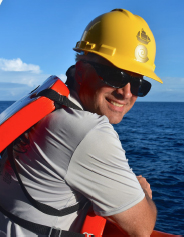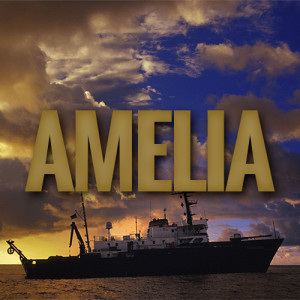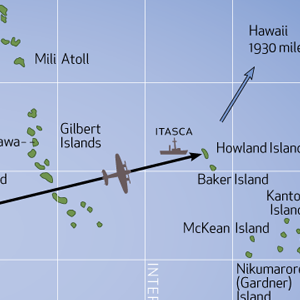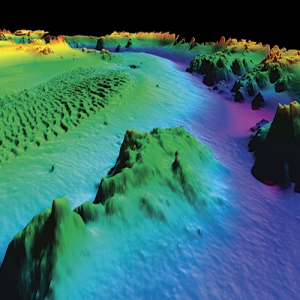Central Pacific Edition
Dateline, South Pacific
Life on Board Ship, When Everything is New
 I am what the seamen call a flat lander. I grew up in Iowa where the land is rich and perfect for growing tall corn. It is also flat and doesn’t move. I joined the Eustace Earhart Discovery Expedition to help outfit the ship and participate in the locating of Amelia Earhart and Fred Noonan’s airplane lost at sea. I, however, have never been to sea. I have sailed on Iowa lakes, canoed rivers and large bodies of water, swam and dove below, so I have some knowledge of water, but these are some things I have learned since going to sea.
I am what the seamen call a flat lander. I grew up in Iowa where the land is rich and perfect for growing tall corn. It is also flat and doesn’t move. I joined the Eustace Earhart Discovery Expedition to help outfit the ship and participate in the locating of Amelia Earhart and Fred Noonan’s airplane lost at sea. I, however, have never been to sea. I have sailed on Iowa lakes, canoed rivers and large bodies of water, swam and dove below, so I have some knowledge of water, but these are some things I have learned since going to sea.
First there are terminologies not heard in Iowa. Many words are familiar but are used in other ways. Bridge, mess, deck, ladder, stores, splice, monkey fist, fathom, and painter are a few.
Other terms are used only at sea. Gunnel, bulwark, scupper, davit, sextant, clove hitch, belay, and rising glass, for example. And the acronyms: FRC, DP, AIS, GPS. We have sea state, swell, chop, and white caps. We have hard hats (not for your head, but for transponder floats). When we say “port,” we are not talking wine. (We had wine onboard for a few days, a gift from SauVage, but we traded it with the Machias for chocolate. It’s a “dry” ship, after all.)
There are lessons to learn every day. My official duties are to help out wherever possible, mostly by assisting the videographer Bill. The first day Bill was filming at the stern, had finished and was returning to the cabin with his gear. I gathered up two arms full, but Dave stopped me with the phrase, “one hand for the ship.” I put down half the load and continued to the ladder. I had heard the phrase from those who had been to sea, but assumed that it was really only when there were heavy seas. Regardless of the sea state the boat is always moving. You cannot climb a stair, gangway or ladder or even walk down the passageway without using the railing.
I will expand a little. The wheelhouse, or bridge is fifty four steps up the ladder from the main deck, or forty six feet above the sea. As we left port the ship would roll in the sea more than twenty degrees. If you were on the bridge the arc length could be twenty feet. You can prance a little on your toes while moving across the deck. When your weight comes down you are on the other side of the bridge. Fun. If you hop in the middle of the bridge the wall, (I mean, “bulkhead”) will come over and slap you before you come down. Lesson relearned. One hand for the ship. Use the railing when crossing the room. (I mean, the “compartment.”)
We are seven days transit from Honolulu, moving at ten knots (11.5 mph) in the middle of nowhere. If you fall overboard and no one notices, you’re not swimming home. Lesson: Always have a spotter near. If you are working at the side or back of the vessel, have a life jacket on. The sea appears endless. You can watch it near, you can watch it far. And it is blue. Not just blue, but blue BLUE blue. At home you occasionally see a nice sunset. At sea there are no objects between you and the horizon, and every sunset and sunrise is perfectly visible and awesome, declaring the Glory of the God.
The night sky has no physical distractions. At the equator night comes early. The skies are generally clear and the stars fill the entire space. The heavenly bodies are a clockwork in space, displaying time and position in a physical way. We have been at sea long enough to view a complete cycle of moon phases. Lessons: Stars whose names are vaguely familiar, constellations traced with a green laser. Sextants, lines of position, and intersects on a chart.
There are no ropes on ships as they are called lines, as in “anchor line.” The line at the bow of a dingy is a painter, the back, a stern line, to the boom on a sail, the sheet. Everything needs to be secured against motion. Often with line. A good knot is not just a pile of tangles. Lesson: different knots for different purposes. Pretty knots for decorative purposes, like gracing a fancy gift bottle of wine or a plain coffee cup handle, or improving grip on the body of binoculars.
Distances are deceiving. Another ship can be seen twelve miles away. An hour later it still looks nearly as far but is half the distance.
There are lessons to be learned everywhere. Open your eyes, be observant. Watch out for your fellow sailor. Like a dry sea sponge, soak up the new environment and be changed, growing fuller and more useful with every drop.
— Bryan McCoy



